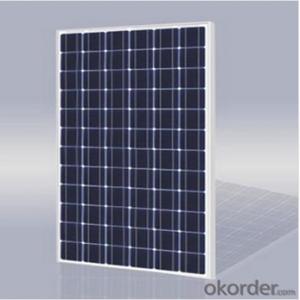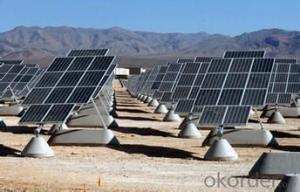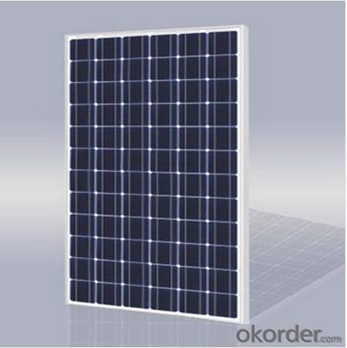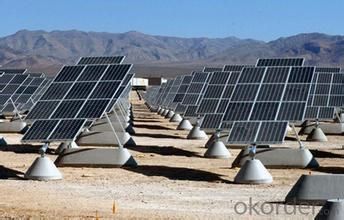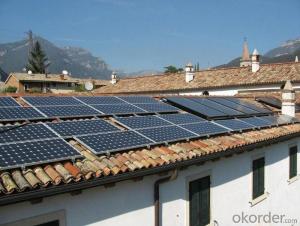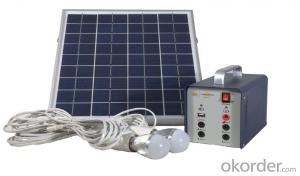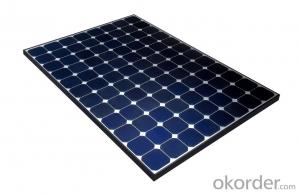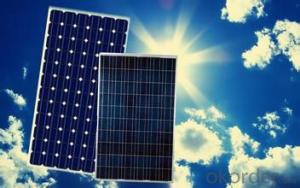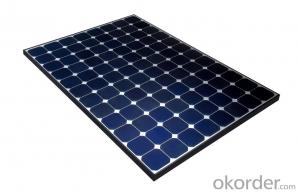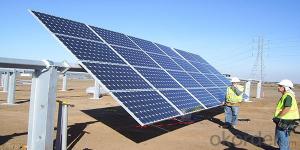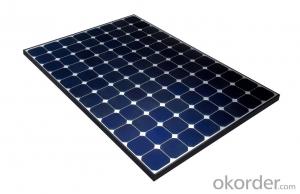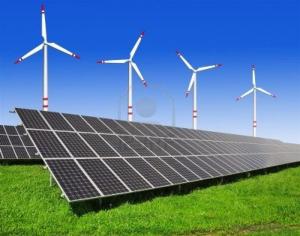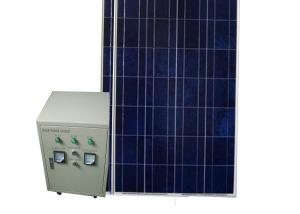Home Solar Energy Systems:130kw CNBM Monocrystalline Silicon Panel for Home Use
- Loading Port:
- Tianjin
- Payment Terms:
- TT OR LC
- Min Order Qty:
- 50 watt
- Supply Capability:
- 1000 watt/month
OKorder Service Pledge
OKorder Financial Service
You Might Also Like
Specification
130KW CNBM Monocrystalline Silicon Panel for Home Using
Production description
Off-the-grid homes are autonomous; they do not rely on municipal water supply, sewer, natural gas, electrical power grid, or similar utility house in the high-desert wilderness of Northern Arizona, collecting rainwater, composting waste, and paying nothing for utilities.[4][5]
The large magnitude of solar energy available makes it a highly appealing source of electricity. The United Nations Development Programme in its 2000 World Energy Assessment found that the annual potential of solar energy was 1,575–49,387 exajoules (EJ). This is several times larger than the total world energy consumption, which was 559.8 EJ in 2012.
Electrical power can be generated on-site with renewable energy sources such as solar (particularly with photovoltaics), wind, micro hydro, geothermal; with agenerator or Micro combined heat and power with adequate fuel reserves. Such a system is called a stand-alone power system. In addition, it is possible to simply eliminate electric power such as in Old Order Amish and Old Order Mennonite communities.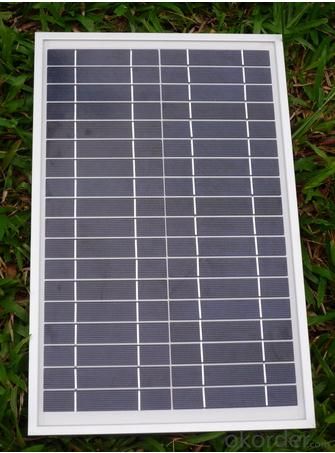
Feature
1.High conversion efficiencies resulting in superior power output performance.
2.Outstanding power output even in low light or high temperature conditions
3.Optimized design for ease of soldering and lamination
Physical characteristic
1. Rigorous quality control meets the highest international standards.
2. High-transmissivity low-iron tempered glass, strong aluminium frame.
3. Using UV-resistant silicon.
4. IS09001/14001/CE/TUV/UL
Packaging
26pcs in one carton 6pallets in 20foot container 14pallets in 40 foot container.
- Q: What is the role of solar energy systems in reducing energy waste?
- Solar energy systems play a crucial role in reducing energy waste by harnessing the power of the sun to generate clean and sustainable electricity. They provide an alternative to traditional energy sources that often rely on fossil fuels, which contribute to pollution and greenhouse gas emissions. By utilizing solar energy, we can significantly reduce our dependence on non-renewable resources and decrease the amount of energy waste associated with their extraction and production. Additionally, solar energy systems help to decentralize energy production, allowing for local generation and consumption, thereby minimizing transmission losses. Overall, the adoption of solar energy systems is vital in mitigating energy waste and promoting a more sustainable and efficient energy future.
- Q: How do solar energy systems affect carbon footprint?
- Solar energy systems have a significant positive impact on reducing carbon footprint. By harnessing the power of the sun, these systems generate clean and renewable electricity, eliminating the need for fossil fuel-based energy sources. As a result, solar energy systems reduce greenhouse gas emissions, helping to mitigate climate change and create a more sustainable future.
- Q: Can solar energy systems be used for powering off-grid refugee camps?
- Yes, solar energy systems can be used to power off-grid refugee camps. Solar panels can generate electricity by harnessing the sun's energy, making them a reliable and sustainable power source for remote locations. Solar energy systems can provide electricity for lighting, charging devices, refrigeration, and other essential needs in refugee camps, reducing their dependence on traditional fossil fuel-based generators and improving the living conditions of refugees.
- Q: Can solar energy systems be used in camping or outdoor activities?
- Yes, solar energy systems can definitely be used in camping or outdoor activities. In fact, solar power is a great solution for off-grid living or when you're away from traditional power sources. Portable solar panels, also known as solar chargers, can be used to harness the sun's energy and convert it into electricity to power various camping or outdoor devices. There are several advantages of using solar energy systems for camping. Firstly, they provide a renewable and sustainable source of power, reducing your reliance on fossil fuels or disposable batteries. This not only helps to protect the environment but also saves you money in the long run. Solar energy systems can be used to charge a wide range of devices, such as smartphones, tablets, laptops, cameras, portable speakers, and even small appliances like coolers or lights. This ensures that you can stay connected, capture memories, or simply enhance your camping experience without worrying about battery life. Portable solar panels are lightweight, compact, and easy to carry, making them ideal for camping or outdoor activities. They can be set up in various ways, including attaching them to a backpack, placing them on the ground, or mounting them on a tent or RV. Some solar chargers also come with integrated batteries, allowing you to store energy for later use, ensuring a constant power supply even during cloudy days or at night. It is worth mentioning that the efficiency and power output of solar energy systems can vary depending on factors like weather conditions, panel quality, and the angle at which they are positioned towards the sun. Therefore, it's important to choose reliable and reputable solar products that suit your specific needs. Overall, solar energy systems are a fantastic option for camping or outdoor activities, providing a clean, reliable, and sustainable source of power. Whether you want to charge your devices, light up your campsite, or power small appliances, solar power can greatly enhance your outdoor experience.
- Q: How does shading affect the performance of solar panels?
- Shading negatively affects the performance of solar panels as it obstructs the amount of sunlight reaching the panels, reducing their efficiency in converting sunlight into electricity. Even a small amount of shading can significantly reduce the overall power output of a solar panel or even render it completely inactive. Therefore, it is crucial to ensure that solar panels are installed in areas with minimal shading to maximize their performance.
- Q: Can solar energy systems be leased or financed?
- Yes, solar energy systems can be leased or financed through various options such as solar leases, power purchase agreements (PPAs), and solar loans. These financing options allow homeowners and businesses to install solar panels and pay for them over time, either through lease payments or loan installments. This makes solar energy more accessible and affordable for a wider range of individuals and organizations.
- Q: How do solar energy systems affect water quality?
- Solar energy systems have a minimal impact on water quality. Unlike other forms of renewable energy, such as hydropower, solar energy systems do not require water for their operation. This means that they do not directly contribute to water pollution or degradation. However, it is important to consider the potential indirect impacts during the manufacturing and disposal of solar panels, which may involve the use of chemicals and materials that can affect water quality if not managed properly. Overall, the environmental benefits of solar energy greatly outweigh any potential water quality concerns.
- Q: Do solar energy systems require a lot of wiring?
- Solar energy systems necessitate a specific amount of wiring, which is contingent on the size and intricacy of the system. Generally, wiring is indeed necessary in solar energy systems to link the solar panels to the inverter and subsequently to the building's electrical panel. This wiring is crucial in transmitting the electricity generated by the solar panels to the appliances and electrical loads in the building. The quantity of wiring required is also influenced by the placement of the solar panels and the distance between the panels and the building's electrical panel. If the panels are installed on the roof, additional wiring might be essential to connect the panels to the inverter, typically positioned inside the building. Conversely, if the solar panels are ground-mounted near the building, the wiring distance may be shorter, resulting in a reduced amount of wiring needed. Furthermore, the complexity of the system can also impact the wiring requirements. For instance, if the system incorporates battery storage or if it is a grid-tied system with net metering, extra wiring might be necessary to connect the batteries or the utility meter. In summary, although some wiring is necessary in solar energy systems, the quantity can fluctuate based on factors such as system size, location, and complexity. It is always advisable to consult with a professional solar installer to evaluate your specific requirements and ascertain the appropriate amount of wiring needed for your solar energy system.
- Q: How does the cleanliness of solar panels affect their performance?
- The cleanliness of solar panels has a significant impact on their performance. When solar panels are dirty or covered in dust, dirt, or any other debris, it reduces their ability to absorb sunlight efficiently. This results in a decrease in the amount of electricity generated by the panels. Dirt and dust particles on solar panels create a layer that blocks sunlight from reaching the photovoltaic cells. This obstruction prevents the panels from converting sunlight into electricity effectively. As a result, the output of electricity decreases, and the overall performance of the solar panels is affected. Regular cleaning and maintenance of solar panels are essential to maintaining their optimal performance. By keeping the panels clean, you allow maximum sunlight to reach the cells, ensuring efficient energy conversion and higher electricity production. This is particularly important in areas with high levels of dust, pollen, or other airborne particles. Moreover, dirty solar panels can also lead to additional issues. Accumulated dirt can trap heat on the surface of the panels, causing them to overheat. This can potentially damage the panels and reduce their lifespan. Additionally, if the dirt or debris is not cleaned promptly, it can corrode the surface of the panels or create scratches, further affecting their performance and longevity. To maintain the cleanliness of solar panels, it is recommended to clean them regularly, especially in dusty or polluted environments. This can be done using a soft brush or sponge with water and mild detergent, ensuring not to scratch the surface. In some cases, automated cleaning systems or specialized solar panel cleaning services may be used for larger installations. In conclusion, the cleanliness of solar panels directly affects their performance. By keeping them free of dirt and debris, you can maximize their ability to absorb sunlight, leading to increased electricity production and improved efficiency. Regular cleaning and maintenance are crucial to ensure optimal performance and longevity of solar panels.
- Q: Can solar energy systems be used in commercial or industrial applications?
- Yes, solar energy systems can definitely be used in commercial or industrial applications. In fact, many businesses and industries around the world are increasingly adopting solar energy systems to power their operations. These systems can be installed on rooftops, parking lots, or ground-mounted, providing a reliable and sustainable source of electricity. Not only does solar energy help businesses reduce their carbon footprint and lower their energy costs, but it also provides them with long-term energy independence and resilience.
Send your message to us
Home Solar Energy Systems:130kw CNBM Monocrystalline Silicon Panel for Home Use
- Loading Port:
- Tianjin
- Payment Terms:
- TT OR LC
- Min Order Qty:
- 50 watt
- Supply Capability:
- 1000 watt/month
OKorder Service Pledge
OKorder Financial Service
Similar products
Hot products
Hot Searches
Related keywords
